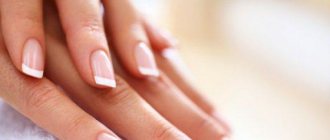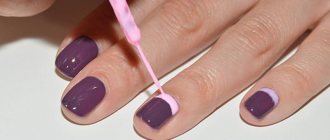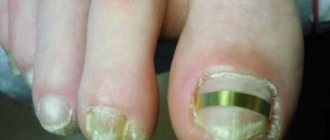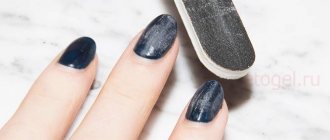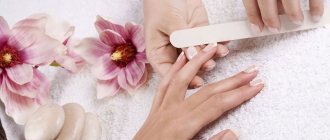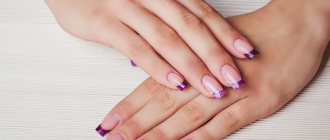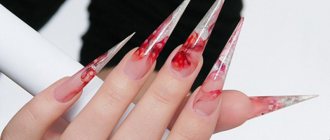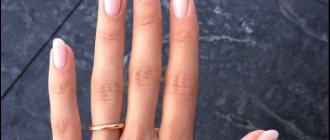First, let's figure out what nail correction after extensions is. This is the correction of minor flaws that may have formed over time. Marigolds, like hair, constantly grow, increasing by about two millimeters in a couple of weeks.
If you have given yourself a manicure with extensions, then as you grow, the appearance of the manicure may change significantly; the shape will need to be corrected. Correction of gel extensions, made using regular varnish or any coating, is based on improving the condition of the cuticle, the shape of the nail plate, as well as the fullness of the decorative layer. Also, the artificial plate is restored, and the manicure returns to its original well-groomed appearance.
What tools are required for the job?
Below is a list of the main tools you will need:
- antiseptic for treating hands and plates;
- gel polish for coating;
- brushes for applying the necessary products.
- nail files, orange sticks to treat nails and cuticles;
- cuticle oil;
- primer is a liquid for basic processing before starting extensions. It completely cleans the surface, protects it from delamination, and ensures strong adhesion of the gel to the nail plate.
Correction of gel nails is based on the same points that are carried out when applying gel polish. The main stage is the removal of the topmost layer using a file or a router. The next stage is applying a new fresh layer.
Process Features
The natural plate grows back in about a month. So after three weeks you will need to update your manicure. Main reasons:
- the edge of the natural plate will begin to appear between the artificial polymer and the cuticle;
- it will be possible to notice that individual parts of the extended surface are damaged.
- the coating can peel off due to a kind of air cushion formed between the polymer and the natural nail plate.
What benefits does correction bring:
- restoring the aesthetic appearance of artificial turf;
- the ability to restore smoothness and strengthen your nails in just a couple of hours;
- hiding all imperfections of the nail plate.
You will have to spend no more time on the procedure than on the extension itself, since only the top layer requires correction. Moreover, well-modeled nail plates do not cause problems, but require regular supervision.
Manicure extensions have their own expiration date. Directly dependent on the ergonomics of the artificial polymer, the quality of the manicure performed, and the lifestyle of its owner.
Be that as it may, regardless of the quality of the work, you will again have to make a gel correction in a beauty salon or do it yourself to return them to their previous appearance. The adjustment will help eliminate deformation of the artificial turf, return it to strength, the desired length, and perhaps even allow you to slightly update the design.
When is it necessary to correct extended nails?
Since nails grow on average two millimeters per week, and even faster after the first extension, correction may be necessary after two, less often, three weeks. Why do you need correction of extended nails? The fact is that the tip (the base of an artificial nail) or a layer of gel is attached to its own nail plate, which, naturally, does not stop growing.
As the nail plate grows, it exposes the place where there is no longer an artificial nail and it looks very unaesthetic, the nail grows longer and longer, and the artificial nail begins to literally hang from it, curving downwards. The manicure becomes very unsightly, besides, the longer the nails grow, the more likely it is that they will peel off and lose artificial nails, which will now have to be re-grown at full cost, instead of correction at half the price. Thus, it becomes clear that it is better not to miss the correction time assigned by the master.
The timing of the correction procedure can vary greatly, as it is directly related to the individual nail growth rate. Those whose nails grow very quickly will have to make corrections more often. To be fair, it must be said that wearing false (gel or acrylic) nails slows down the growth of the nail plate and a good manicure retains its neat appearance much longer.
Step-by-step execution
The following is a guide to the standard adjustment process at home. Step-by-step gel correction consists of the following points:
- Disinfect manicure tools, hand skin and plates.
- Remove the paint layer. To do this, it is advisable to take liquids that do not contain acetone.
- Lift the cuticle using a wooden stick.
- Correct the shape of the nail with a nail file or a router, first removing those pieces of gel that have already begun to fall off. Afterwards, remove the gel closer to the cuticle. Thus, you should have an invisible transition from a thin layer of polymer to a natural plate.
- Treat with a primer to prevent infection. Excess can be removed with a lint-free cloth.
- The overgrown nail plate itself can be leveled with a buff. Immediately after this, apply the gel and send it to dry under the lamp.
- When the polymer has dried, remove the sticky layer with a special liquid, eliminate all possible irregularities, and give the plate the desired shape. The base layer of gel should be applied evenly. For the area slightly above the middle of the nail you will need a little more gel, but do not overdo it. Place it under the lamp to dry again.
- Fix the last possible defects. Be careful not to erase the new layer of gel into the old one.
- As you work, do not forget to remove excess dust with a brush or lint-free wipes.
- Complete your desired design before applying the sealer.
11.Apply the fixative in one layer, dry under the lamp. To give additional smoothness, you can treat the surface with buff.
12.To complete the procedure, treat the cuticle and skin around the plates with special oil.
Correction of acrylic nail extensions is carried out in a similar way, if we consider it step by step. The only condition is that you will have to pay closer attention to ensure that the acrylic varnish, when applied, does not get on the skin around the nails or in the sinuses. In case of contact, the substance must be carefully removed immediately.
Nail correction step by step
An experienced nail salon specialist will repair extended nails quickly and efficiently, because he has all the special tools at hand. At home, the procedure will take longer, and it will be inconvenient to do it yourself. But if the decision to get a home manicure has already been made, you need to adhere to a certain algorithm of actions. Otherwise, the correction will be of poor quality, and the natural nail plates may be damaged.
To correct gel nails, you need to do the following:
- Remove decorative topcoat. To do this, the entire surface is filed with a file with an abrasiveness of 120-180 grit.
- Level the artificial turf at the joint so that it is flush with the natural one. This must be done carefully, trying not to touch the living nail.
- Using the same file, adjust the length and shape. This leaves a thin, previously formed tip on which the gel can be reapplied.
- If the artificial nail was severely broken, then it is removed completely, back to the natural one.
- Remove dust thoroughly
- Use a wooden stick to push back the cuticle. If it has grown too much, you need to trim it, or use a remover to remove it.
- Sand the live plate a little
- When completely replacing the nail, at this stage the shape is set, or the tips are glued and filed.
- Apply degreaser or bonder to the regrown area and allow to dry.
- Cover the entire area with primer.
- The preparatory stage is over, you can start applying the material
- Apply a thin layer of base and polymerize. The gel should not touch the skin and cuticles
- Form a shape using construction gel, paying attention to the new stress zone, dry in a lamp
- Use a file to remove all excess and unevenness.
- Cover with a finishing layer
- After polymerization, treat the areas around the nails with nourishing moisturizing oil. As a last resort, you can use cream
Now you can decorate your nails. A simple design can be made after applying the modeling gel, before the finishing layer. Thus, the decor will be reliably protected. But if it is a 3D design such as sculpting or liquid stones, it should be done as a last resort as any coating on top will ruin the whole look.
Gel is used most often today, as it is more convenient to apply. But many craftsmen prefer acrylic; it is believed to be stronger and more flexible. Acrylic nails are corrected according to the same scheme as gel nails, only instead of the three phases of applying the gel, acrylic is laid out, polymerized and filed.
Shellac can also be corrected, although it is not recommended to wear it for longer than the prescribed two weeks in a row. Here the procedure is simplified, since only the regrown area is corrected. The coating is applied as easily as regular varnish. Therefore, it does not require additional filing; shellac is evenly applied in a thin, even layer.
In conclusion, we can conclude that correction, like extension, is a very complex process; a beginner will not be able to do it perfectly the first time. Therefore, it is better to first try to do one nail, and if the result is satisfactory, continue further. Over time, your hand will become fuller, the quality will be better, and you can safely correct your nails at home.
Extended nails allow many women to realize the dream of a beautiful manicure. However, no matter how well the extension is done, the nail plate grows along with the artificial nail, which means you will have to go to a specialist for correction.
Correction is also necessary in case of nail breakage or peeling.
How often do nail corrections be done?
?
The answer to this question will be given by the master, who will select a schedule for repeat visits based on the growth rate of the nail plate. On average, you will have to visit the salon every 3-4 weeks.
During the correction procedure, the master removes the artificial coating (acrylic is dissolved with liquid, and the gel is cut off) and reapplies it.
As a result, the manicure again takes on a neat and beautiful appearance.
Correction of artificial plates can be performed in different ways.
The following types of this procedure are distinguished:
- Minor – performed for minor damage, usually resulting from mechanical impact (scratches, chips, peeling).
- Medium – carried out monthly to update the artificial turf. The master applies the gel or acrylic again to remove the visible difference between the artificial and regrown natural nails.
- Large – involves replacing the artificial plate if it breaks, is displaced, or is detached.
Gel correction is performed as follows:
1.Before starting the procedure, hands are disinfected with a special means.
2.Get a manicure with cuticle removal.
3. We use a 220-grid file along the regrown part of the nail, smooth out the transition zone of our own and the extended nail, sand the entire surface and remove the coating (shellac or varnish), the file is carried out as when preparing the nail for extensions.
Step-by-step correction of gel nails
Remove excess length and give shape. This must be done carefully so as not to injure the skin around the nail plate. At the end of the procedure, the dust is brushed off with a brush.
4.For correction while leaving the previous extension material, a couple of new layers of gel will be required. Apply a thin layer of gel with a brush to the cleaned, regrown surface and the rest of the nail, filling the niches after sanding. We dry the nails in the lamp, apply another layer of gel and send the nails to dry again.
You also cannot do without polishers or buffs. They help give your nails shine and smoothness. Buffs have 4 sides, each with its own grain size. The sides are labeled with numbers so you can easily figure out which order to use them in.
4. Degreasing - this will require a special liquid, for example, inexpensive from “Severina” or “Domix” or better known from “Jessica”.
5. Application of primer - they are also presented as affordable and suitable for home use (“Irisk”, “Tango”), as well as expensive and used in salons (“CND”, “OPI”).
6. Applying a base coat - for home use, you can purchase an inexpensive base coat from SuperNail or UV Bonder.
7.Applying gel – the most popular are “Planet Nails”, “EzFlow”, “IBD”, “Masura”. Also purchase a brush from a specialty store.
8.Polymerization under a lamp - this requires a special UV lamp. They have different powers - from 9 to 36 Watts and a timer for 10, 30, 60 seconds.
9.Applying the finishing coat – for gel correction, products from Severina, Top Gloss-gel, and TNL are recommended.
How to correct acrylic nails
In addition to gel extensions, acrylic extensions are also popular. To carry out the correction, you must first remove the old coating.
It is performed as follows:
- The master disinfects his hands with soap or a special solution.
- The varnish coating is removed with ordinary nail polish remover, but always without acetone.
- Then the master does a manicure, removing hangnails and cuticles. For heavily overgrown nails, it is necessary to remove the shine with a fine-grain nail file.
- The periungual bed must be covered with adhesive tape to prevent acrylic from getting on the skin and cuticle. Then an acid primer is applied.
- A brush with bristles is moistened in monomer and dipped in acrylic powder. An acrylic ball is obtained, it is carefully stretched over the surface. The acrylic layer is polymerized under a UV lamp.
- After correction, the nail is given the desired shape, first with a file with a large grain, and then with a fine one. The procedure is completed by polishing with a buff.
If you're tired of getting your nails done
With the advent of permanent shellac and gel polishes on the nail industry market, the popularity of extensions has decreased somewhat. This is due to the fact that gel polishes also stay on the plate for at least 3 weeks and do not require filing.
As a result, you can quickly grow natural nails.
Gel polishes have the following advantages:
- lasts a long time, does not chip, does not lose color intensity,
- easy to apply and remove, so they are often used at home,
- do not have an unpleasant odor, rarely cause allergies,
- When removed, the plate is not injured.
- help in strengthening and restoring nails.
Manicures with shellac and gel polishes are offered by almost all beauty salons, and the procedure for both application and correction takes less time than with extensions.
The choice of colors is incredibly large, and experienced craftsmen create various designs and complement them with decorative elements.
But no matter what coating you choose - gel, acrylic or shellac, do not forget about timely correction, and then your nails will remain beautiful and healthy.
For many women today, problems such as brittleness and poor nail growth are pressing. Defects due to mechanical trauma and damage are also common. In a beauty salon, manicurists solve this problem using a procedure such as gel nail extensions.
Types of corrective procedures
Correction of extensions may vary depending on the design or condition of the nail plates. There are usually three variations:
- Small. The manicure is slightly damaged, there are few peelings. Accordingly, the procedure is performed in a shorter time, using a small number of instruments.
- Average. There is a need to hide the area of the overgrown natural plate, which spoils the appearance of the manicure. On average, a nail grows up to five millimeters, and there is a risk of damage.
- Large. This is the case when nail extensions and nail correction are practically the same thing. It is necessary to completely form a new polymer and change the design.
It is worth recognizing that correcting a French manicure with gel is a rather complicated process. To carry it out you will need knowledge and well-honed skills. A distinctive feature is the difference in the processing of the base of the plate and the tip of the nail.
When there is no point in applying the “smile” (tip of the nail) again, the French manicure is adjusted according to the standard scheme. The “smile” is difficult to correct; maximum attention should be paid to this process. This is due to the need to correct nails when transferring “tendrils”, which create a gap between natural and extended nails. For more successful development of skills, it will be useful to watch special photos or video lessons.
How to do nail correction
Before making extensions, you need to take into account that over time it will be necessary to carry out corrections. Without this, a neat manicure is impossible. Neglecting this important procedure is fraught with both an unaesthetic appearance and injury to the natural nail plates. The main reason for correction is the natural growth of nails. This process means moving the artificial plate forward and freeing up the natural nail area at the root. Tightening with correction is tantamount to peeling the material. And if a design is made on artificial nails, then with the growth of natural nails it looks sloppy.
Another reason is the possibility of changing the shape of the nails. They may break. Then the master glues the damaged area, if possible. If not, then fixing the breakdown will essentially become a new build.
It is customary to divide nail correction into three types. Minor correction consists of minimal intervention and elimination of minor mechanical damage. Medium implies a mandatory planned procedure. Major corrections are made when the material detaches, changes in the shape of the nails, and possibly displacement. In the last type of correction, the work of the master will be quite long, similar to extensions.
The correction procedure consists of several stages:
- Disinfection of each nail with an antiseptic solution. After this, the master pushes back the cuticle and removes it with exfoliating lotion.
- Thorough treatment of nail surfaces with a nail file. The top ball is removed from the grown part of the native nail for better adhesion to the artificial material.
- About half the thickness of the old extended nail is filed down. That is, the design is also deleted. This allows you to create a renewal of the nail plate.
- Application of new modeling material. These are acrylic balls or sculptural gel (depending on the source material). The modeling material fills the area of the regrown native nail and is compared with the extended part. In this case, the master pays special attention to the border between these two parts.
- After the base of the new shape has been formed, you can make a new design for the nails or simply cover them with varnish at the woman’s request.
The correction procedure has its difficulties and advantages. Correction opens up wide possibilities for changing manicure for owners of artificial nails. Women use this opportunity to make him look diverse. This includes a French manicure on extended nails, floral designs, a modest coating of colorless varnish, and a chic modern design. If an aquarium design was originally made on the extended plates, sealed inside the mold, then it is unlikely that it will be possible to completely restore the design.
When mechanical damage occurs to acrylic nails, their correction is less painful compared to gel nails. Gel will need to be filed away, while acrylic can be dissolved.
If we talk about the procedure for medium correction, then it depends on the growth rate of the native nail plates. Some women grow their nails very quickly, while others hardly grow. Therefore, correction is usually done once every 2-4 weeks. During this time, natural nails grow up to 4 millimeters. As a rule, the cost of a professional correction procedure is equal to 50% of the price of a full-fledged extension. The time to perform this manipulation is from an hour to two. This depends on the type of correction of the source material for extension. If you need a full-fledged modeling, the procedure will take longer.
Maximum number of corrections allowed
The length of time your manicure will last depends on the rate of growth of the nail plate, as well as how you care for your hands. Most often, correction is carried out once every three to four weeks, but sometimes it has to be done more often. At the same time, it is useful to know how many times you can renew your manicure.
It all depends on the raw materials used to apply the manicure. For example, gel extensions allow you to do four to five repetitions. After this, the gel coating deteriorates and requires replacement or removal.
Cost of correction in salons
In Moscow there are certain lists of masters, indicating their reviews of the work. This allows you to find a suitable specialist and not fall into the unreliable hands of a beginner who can ruin your nails.
The price of the correction service depends on the material used, as well as on whether you are ready to visit a specialist or want to call him to your home.
On average, the cost of this service is about 1.5 thousand rubles. However, you can find it more expensive - for 2 thousand, and even 2.5 thousand rubles.
